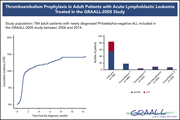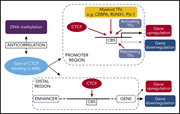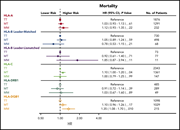Issue Archive
Table of Contents
BLOOD COMMENTARIES
PLENARY PAPER
An evolutionarily ancient mechanism for regulation of hemoglobin expression in vertebrate red cells
In a Plenary Paper, Miyata and colleagues reveal that even though the protein-coding genes for globin are genomically distinct and evolved independently in jawed and jawless vertebrates, they share a key regulatory element arising at least 400 million years ago. This extraordinary preservation of regulation of tissue-specific expression helps explain an enigma about convergent evolution in globin genes.
CLINICAL TRIALS AND OBSERVATIONS
Bleeding and response to hemostatic therapy in acquired hemophilia A: results from the GTH-AH 01/2010 study
Clinical Trials & Observations
Using data from a prospective registry, Holstein et al describe factors associated with bleeding risk in patients with acquired hemophilia A after the start of immune therapy. Weekly measurement of factor VIII activity may help to assess the individual risk of bleeding, and that risk remains high until factor VIII levels recover to ≥50%.
HEMATOPOIESIS AND STEM CELLS
The transcription factor ETS1 is an important regulator of human NK cell development and terminal differentiation
Taveirne and colleagues utilized CRISPR deletion and transduction approaches in human embryonic stem cells and cord blood hematopoietic progenitors to show the importance of the transcription factor ETS1 upstream of other key regulators of natural killer (NK) cell development and terminal differentiation.
IMMUNOBIOLOGY AND IMMUNOTHERAPY
UBR5 HECT domain mutations identified in mantle cell lymphoma control maturation of B cells
Approximately 18% of mantle cell lymphoma patients have mutations in UBR5. Swenson et al explored the functional importance of mutations in its HECT domain, revealing a role in stabilizing spliceosome components that impact B-cell maturation, with potential relevance for lymphomagenesis.
LYMPHOID NEOPLASIA
Impaired condensin complex and Aurora B kinase underlie mitotic and chromosomal defects in hyperdiploid B-cell ALL
Molina et al explored the molecular basis for hyperdiploidy in B-cell acute lymphoblastic leukemia. They investigated primary pediatric samples identifying chromosome structure and condensation defects that can be reproduced, with hyperdiploidy, in normal CD34+ cells upon inhibition of Aurora B kinase and/or the spindle assembly checkpoint.
Thromboembolism prophylaxis in adult patients with acute lymphoblastic leukemia treated in the GRAALL-2005 study
CME
Clinical Trials & Observations
In this month’s CME article, the authors explore the issue of thromboembolism in adult patients receiving intensive l-asparaginase–containing regimens in a 784-patient trial. They describe a 16% incidence of thrombosis, despite various prophylactic measures, including antithrombin III administration. These data provide the rationale for a prospective interventional trial in adults to address this clinical dilemma.
MYELOID NEOPLASIA
AML displays increased CTCF occupancy associated with aberrant gene expression and transcription factor binding
Mujahed and colleagues investigated the role of the chromatin-organizing protein CTCF in acute myeloid leukemia (AML) by comparing AML cells with normal progenitor cells. They found that increased and aberrant CTCF binding to DNA in AML is associated with aberrant gene expression and transcription factor binding. These changes can be partly restored towards normal by azacitidine.
THROMBOSIS AND HEMOSTASIS
Open ADAMTS13, induced by antibodies, is a biomarker for subclinical immune-mediated thrombotic thrombocytopenic purpura
Clinical Trials & Observations
Roose and colleagues investigated immune-mediated thrombotic thrombocytopenic purpura (iTTP), revealing that in vitro anti-ADAMTS13 autoantibodies induce an open conformation of ADAMTS13 mimicking the conformation seen in vivo during the acute phase of active disease. They also provided evidence that open ADAMTS13 may be a novel biomarker to detect subclinical iTTP in previously affected patients.
TRANSPLANTATION
HLA-B leader and survivorship after HLA-mismatched unrelated donor transplantation
Petersdorf and colleagues continue to develop a new paradigm to improve donor selection for unrelated donor allogeneic hematopoietic stem cell transplantation by exploring how survival outcomes are associated with dimorphism at the HLA-B leader peptide sequence, a region not tested in routine HLA matching. Their data suggest that we can reduce the transplant risks associated with HLA mismatching by considering HLA-B leader genotype.
LETTER TO BLOOD
BLOOD WORK
CONTINUING MEDICAL EDUCATION (CME) QUESTIONS
-
Cover Image
Cover Image
![issue cover]()
Confocal microscope capture of a primary B-cell acute lymphoblastic leukemia blast in metaphase. Cells were immunostained for the mitotic spindle with antibodies recognizing tubulin (green) and for centromeres with antibodies recognizing centromere protein A (CENP-A; red). DNA was stained with 4′,6-diamidino-2-phenylindole (DAPI; blue). See the article by Molina et al on page 313.
- PDF Icon Front MatterFront Matter
- PDF Icon Table of ContentsTable of Contents
- PDF Icon Editorial BoardEditorial Board
Advertisement intended for health care professionals
Email alerts
Advertisement intended for health care professionals












A Cambrian origin for globin gene regulation